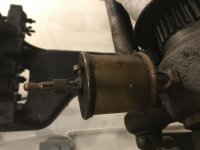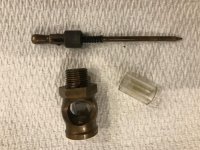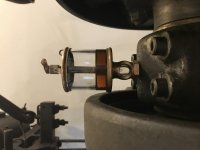I run ISO 46 oil in my old machine tools and much else. It is available in 2 gallon jugs at places like Tractor Supply, sold as "Tractor Hydraulic Oil". Tractor Hydraulic Oil is a DTE medium (ISO 68) or DTE Light (ISO 46, I think). Tractor hydraulic oil is a DTE (Dynamo, Turbine, Engine) oil, straight weight, mineral base, with anti foam and anti corrosion additives. Plenty good for old machine tools with plain bearings and for older geared-head machine tools.
DTE usually does not have "number" weights or grades. Typically, DTE oils are specified as "Light, Medium, Heavy-Medium, and Heavy". An ISO viscosity rating now accompanies the DTE classification. ISO 46 is about an SAE 20 weight oil. ISO 32 may be too thin for your application and will run out of the bearings as fast as the lubricator drips it in.
As for drip rate on the lubricators, I like to see a couple of drops a minute at most. Nothing precise about it. Start the lathe once you have established oil flow from the lubricators to the bearings. Run the spindle at each speed (in "direct", not back gears) and feel the bearing caps. If they are getting hot rapidly, open the lubricators wide, flood the oil to it, and loosen the bearing cap bolts. You may have set a bearing up too tight and will need to add maybe a 0.001" shim. If the bearings take their time in getting warm (if at all), after about 10 minutes of running at the lowest speed, shift the belt to the next steps on the cone pulleys and kick the speed up. Repeat the process, feeling for hot bearings. There are two loose rules about this: if a bearing gets hot rapidly, it is likely setup too tight; and, if you cannot keep your hand or fingers comfortably on a bearing cap, it is running too hot and is setup too tight. Use the backs of your hands/fingers to feel for bearing temperature as the tips and front of your fingers/palm may be too callussed to give you an accurate feel. Kind of like a mother feeling a child's forehead for fever, using the back of the hand.
At the highest spindle speed in "direct", if the bearings begin to warm up, increase the oil drip rate a bit and see if the temperature of the bearing(s) stabilizes.
When this happens, the lathe should be ready for use and taking some trial cuts. Oil is cheap at the price.
BTW: the old drip lubricators used compressed cork gaskets between the glass and the brass end flanges. The cork avoided putting localized high stress on the glass (which may not have been cut off entirely flat or squarely), with resulting breakage of the glass. The cork gaskets were sealed with gasket shellac, a blackish product that is probably ancient history now that RTV gasket eliminator and silicon gaskets have taken over from the old cork gaskets. The old cork gaskets are probably about like petrified dinosaur droppings at this point, courtesy of the gasket shellac. We used to buy a small bottle of "Indian Head Gasket Shellac" in the auto parts stores when we worked with cork rocker cover gaskets back 'in the day. If you need new gaskets for the lubricators, some of the suppliers of restoration supplied for the "hit and Miss" gasoline engines such as "Starbolt Supply" may have the cork gaskets. There is enough thickness and "give" in the cork gaskets, making them ideal for use on the lubricators. All too easy to slop on the RTV Gasket Eliminator (or similar), then make up on the lubricator center stem to draw the end flanges tight on the glass... and either it leaks or the glass goes bust.
In short, get oil flowing to the bearings, and if they run cool at high speeds, you are good to go. Determining what oil to run is another matter. I personally would for an ISO 46 oil given the type of bearings, type of machine tool, and spindle speeds. The oil needs some "body" to it to maintain a wedge-shaped film in the bearings under load. With lower speeds and heavier loadings and looser bearing clearances than something like a surface grinder spindle might have, I'd stick with the ISO 46 and not lose any sleep over it.
John Oder is correct in that these old machine tools used "total loss" lubrication. In the old shops, they used to get bundles of "cotton waste" for wipers. Cotton waste is the odd threads and small trimmings from textile and garment manufacturing. It is probably an obsolete thing, and even the hemmed red shop cloths are getting fewer. Disposable shop wipes by the roll are in common use. In the old days, the waste was freely used, and there were (if the shop was safety minded), special galvanized steel containers that were fire-rated to hold the oily waste when the machinists or wipers were done with it.
Oil and shop wipers are cheap at the price, so don't be stingy with either of them. A lot cheaper than having a spindle journal seize in a headstock bearing with resulting damage.













